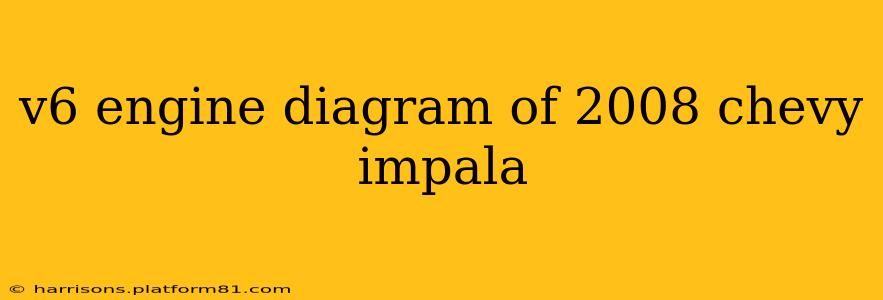Decoding the 2008 Chevy Impala's V6 Engine: A Detailed Diagram and Explanation
The 2008 Chevrolet Impala offered a couple of V6 engine options, making a simple diagram impossible without specifying the exact engine code. However, we can explore the general architecture of these engines and address common questions surrounding their design and function. This guide will provide a comprehensive understanding, going beyond a simple visual to delve into the workings of this popular powerplant.
Understanding the 2008 Chevy Impala V6 Engine Options
The 2008 Impala primarily featured two V6 engines: a 3.5L and a 3.9L. Both were variations of General Motors' reliable pushrod V6 design. While a precise diagram specific to each engine code would require accessing proprietary GM documentation, we can discuss their shared features and key differences. These engines were renowned for their balance of power and fuel efficiency, making them a popular choice for the Impala.
What are the key components of a 2008 Chevy Impala V6 engine?
A typical V6 engine, including those found in the 2008 Impala, consists of several crucial components working in harmony:
- Engine Block: The foundation of the engine, housing the cylinders where combustion occurs. This is typically cast iron or aluminum alloy.
- Cylinder Heads: Located atop the engine block, these contain the valves (intake and exhaust) that control the flow of air and fuel into and out of the cylinders.
- Pistons and Connecting Rods: The pistons move up and down within the cylinders, driven by the explosion of the air-fuel mixture. Connecting rods transfer this motion to the crankshaft.
- Crankshaft: This converts the reciprocating motion of the pistons into rotary motion, which ultimately powers the wheels.
- Valvetrain: This system includes the camshaft(s), lifters, pushrods (in the case of the Impala's pushrod design), and rocker arms, all working together to open and close the valves at the precise moments during the combustion cycle.
- Intake Manifold: Delivers the air-fuel mixture to the cylinders.
- Exhaust Manifold: Collects the exhaust gases and directs them to the catalytic converter.
- Fuel Injectors: Precisely meter fuel into the intake manifold or directly into the cylinders (depending on the specific engine's design).
- Ignition System: Provides the spark to ignite the air-fuel mixture within the cylinders.
- Oil System: Lubricates the engine's moving parts to reduce friction and wear.
- Cooling System: Regulates the engine's temperature to prevent overheating.
What is the difference between the 3.5L and 3.9L V6 engines in the 2008 Impala?
While both engines share the basic architecture described above, the 3.9L engine generally offered slightly more horsepower and torque than the 3.5L. This difference primarily stems from the increased displacement (the total volume of all cylinders). The 3.9L engine likely employed slightly different internal components, such as pistons and connecting rods, optimized for its higher power output. Other differences might include variations in the intake and exhaust manifolds and the engine management system's calibrations.
How can I find a detailed diagram of my specific 2008 Chevy Impala V6 engine?
Unfortunately, detailed, high-resolution diagrams of specific engine components are often proprietary information held by auto manufacturers. However, you may find some basic diagrams through online automotive parts retailers (be sure to specify your exact engine code – found on an engine sticker – for accurate results). Repair manuals, often available online or from auto parts stores, provide more detailed information, including exploded views of various engine subsystems.
Where can I find information about maintaining my 2008 Chevy Impala's V6 engine?
Your best resource for maintenance information is your owner's manual. This document provides recommended maintenance schedules and procedures for your specific vehicle. Additionally, reputable online forums and automotive repair websites offer valuable advice and troubleshooting tips from experienced mechanics and car enthusiasts. Remember to always consult a qualified mechanic for major repairs.
By understanding the core components and general design of the 2008 Chevy Impala's V6 engine, you can better appreciate its functionality and approach maintenance and repairs more effectively. Remember to always consult your owner's manual and a qualified mechanic for specific needs.
